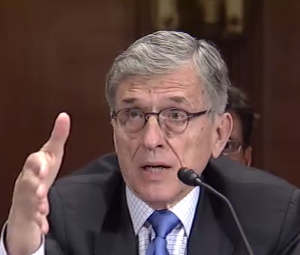The Federal Communications Commission voted 3-2 Thursday in favor of a plan to expand the agency’s Lifeline phone subsidy program for low-income Americans to include broadband — the most contentious issue to divide Republicans and Democrats on the commission since net neutrality.
Chairman Tom Wheeler and Democratic Commissioners Mignon Clyburn and Jessica Rosenworcel voted to expand the program and give Lifeline subscribers the option to purchase broadband Internet service with the $9.25 monthly subsidy, currently used by low-income Americans to purchase landline or mobile phone service.
“At a time when America does business online, why should we continue to spend rate-payer funds only on 20th Century narrow-band service,” Wheeler said during Thursday’s open meeting at FCC headquarters in Washington.
“Why shouldn’t rate-payers — those hard-working Americans — know that their support is going to go help students learn, veterans to apply for benefits, job-seekers to apply for employment and a myriad of other modern challenges that increasingly can only be met online?”
Wheeler also pointed out that despite the political divide over the issue, Lifeline was both put in place and expanded under Republican presidents and past commission votes.
“Those who dissent on this notice today are against cleaning up the invitation to waste, fraud and abuse created by how the program was originally designed and managed,” Wheeler said.
Included in the expansion are reforms that would no longer let service providers determine the eligibility of enrollees for the subsidy — a measure Wheeler described as not only a conflict of interest, but akin to “letting the fox guard the hen house.” Under the expansion, providers would also be permitted to retain documents confirming enrollees’ eligibility, which they are currently barred from keeping.
Republican Commissioners Ajit Pai and Michael O’Rielly voted against expanding the program. Both argue Lifeline is inundated with fraud and abuse, and needs to be reformed before it can be expanded.
According to Pai, today’s Lifeline program, which came to be known as the “Obama Phone” program after it was amended to offer free instead of discounted phone service and a free phone, is far different from the iteration put in place 30 years ago under the Reagan administration.
“To equate the two is like saying that ‘The Godfather: Part II’ is the same as ‘Paul Blart: Mall Cop 2′ because both are movie sequels,” Pai told meeting attendees.
“My priorities for the Lifeline program, which I outlined almost a year ago, are clear. We must implement meaningful reforms to restore fiscal responsibility. We must root out waste, fraud, and abuse. We must target Lifeline spending on those who really need the help. And we must ensure that dollars coming from hard-working Americans’ phone bills each month are wisely spent.”
The Lifeline program was enacted in 1985 to help low-income Americans get telephone service by providing them with a subsidy to help cover the cost. The program was expanded to include cell phone service in 2005, and after the housing and financial crisis began in 2007, grew exponentially in use and cost. The Lifeline budget rose an average of more than 25 percent per year from $821 million in 2008 to $2.1 billion in 2012.
Part of the rise in cost came from widespread fraud and abuse across consumers and wireless providers. According to the FCC, 41 percent of the program’s more than six million subscribers in 2012 failed to provide eligibility documentation, with many subscribers enrolling multiple times with falsified information to obtain the free cellphone and $9.25 monthly subsidy. Meanwhile, wireless providers including Conexions Wireless, I-wireless and True Wireless were enrolling the same customers multiple times for profit.
The FCC implemented reforms in 2012, including a database to prevent duplicate enrollees and fining providers $96 million for negligence and fraud, and brought the cost of the program down to $1.6 billion in 2014. Lifeline is paid for by the FCC’s Universal Service Fund, made up in part by a “universal service fee” attached to Americans’ monthly phone bills — typically a few dollars based on a percentage of the total bill.
“Today, Lifeline spending and enrollment are still almost double what they were at the end of 2008,” Pai said. “Waste, fraud, and abuse are still rampant. And in a report issued earlier this year, the nonpartisan Government Accountability Office (GAO) ‘concluded that the Lifeline program, as currently structured, may be a rather inefficient and costly mechanism to increase telephone subscribership among low-income households.'”
The GAO report went on to note the “risk of significant costs to the program are even greater [with respect to broadband than voice] given that [the] FCC notes that a lesson learned from the broadband pilot program is that higher monthly subsidies have the highest participation rates.”
“Let me be clear. I am open to having a conversation about including broadband in the Lifeline program,” Pai said. “But any such change must go hand-in-hand with the reforms that are necessary to producing a fiscally responsible program. And this proposal fails that basic test.”
Pai and O’Rielly outlined a number of reforms they would have to see attached to any Lifeline expansion before they could vote for it, including a capped budget, a reduction in incentives to reduce fraud, a requirement for enrollees to make some contribution to their subsidized plans, and more aggressive enforcement from states and the FCC.
Following the vote Thursday, the agency will open a window to hear public comment on whether the program should be placed on a fixed budget, and what metrics should be used to grade its efficiency.

